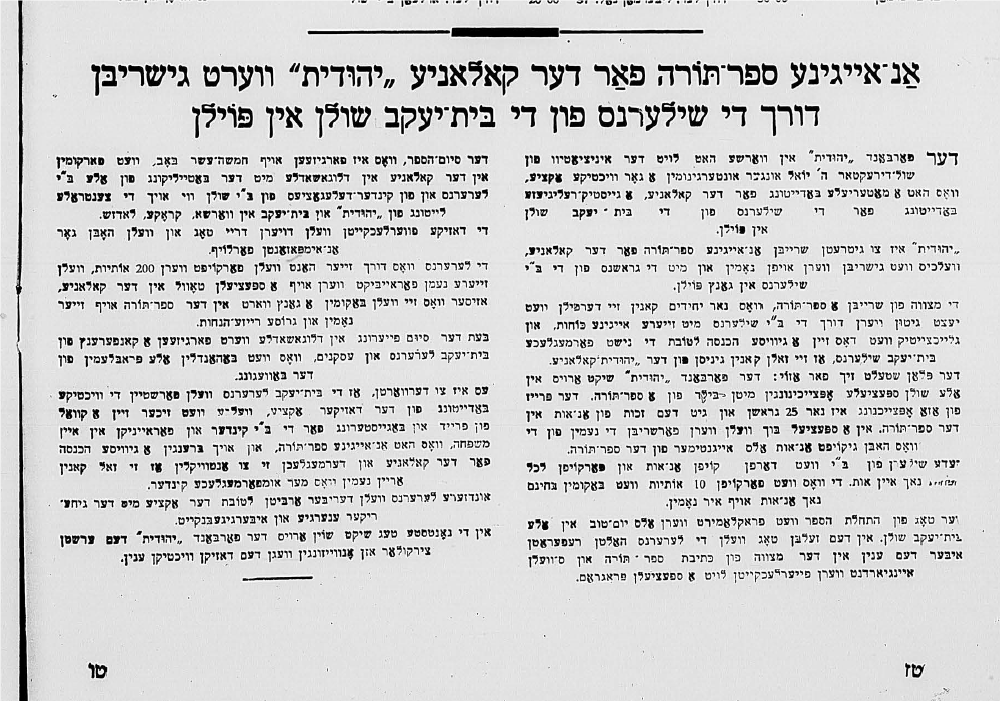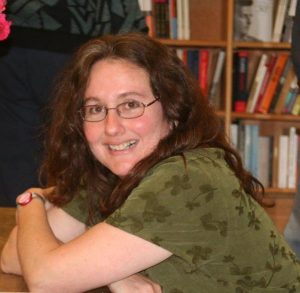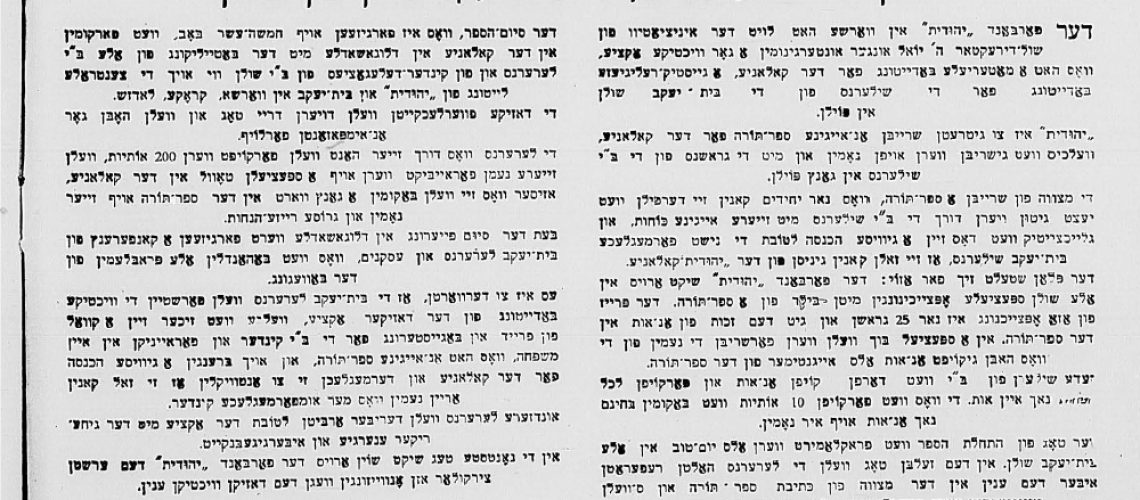The fact that Bais Yaakov resists any suggestions that it is a feminist phenomenon does not mean that teachers do not have to contend with students pressing to know, for instance, why girls don’t dance with the Torah on Simhas Torah, or even touch it. I was one of those students. When I asked Rebbetzin Bruriah why we couldn’t dance with a Torah on Simchas Torah, when we were spending all our time learning Torah, she responded to by saying, “I do dance, I just dance in my seat.” Torah scrolls just aren’t for girls, however better than their brothers they may be when it comes to knowing it (as opposed to the Talmud, which is the major curriculum in yeshivas). Certainly I never saw a Torah scroll at a Bais Yaakov school or camp. Are there some who have one, not for the men but for the girls and women?
So I was pretty surprised to read a report in a 1933 issue of the Bais Yaakov Journal about a girls’ camp commissioning a Torah scroll:
The Yehudis Camp has its own Sefer Torah written with the support of the students of the Polish Bais Yaakov schools
The Yehudis Association of Warsaw, through the initiative of the school director Mr. Yoel Unger, has undertaken an important initiative, with a material significance for their camp and a spiritual-religious significance for the students of the Bais Yaakov schools in Poland.
Yehudis has undertaken to have its own Sefer Torah written for their summer camp, which will be written in the name of and with the pennies of the Bais Yaakov students throughout Poland.
The mitzvah of writing a Sefer Torah, which only a few individuals have fulfilled, will now be fulfilled by the Bais Yaakov students with their own energies, and at the same time this will raise funds for scholarships for less well-off students to attend the Yehudis Camp.

 The article goes on to describe the efforts to raise funds for the Sefer Torah and for scholarships to the camp throughout Poland, with girls buying letters and schools taking the opportunity to teach the laws of the Torah scribe, and the mechanisms of inscribing a Torah. Teachers who raised funds for 200 letters would have their names inscribed on a special plaque in the camp. The installation of the Torah scroll, the report continues, took place beginning on Tu Be’Av in the camp, with festivities, a conference, and other programs going on for three days. As it concludes, the act of collectively inscribing a Bais Yaakov Sefer Torah would certainly create a groundswell of joy and enthusiasm for Bais Yaakov girls, “uniting them in one family, which has one Sefer Torah.”
The article goes on to describe the efforts to raise funds for the Sefer Torah and for scholarships to the camp throughout Poland, with girls buying letters and schools taking the opportunity to teach the laws of the Torah scribe, and the mechanisms of inscribing a Torah. Teachers who raised funds for 200 letters would have their names inscribed on a special plaque in the camp. The installation of the Torah scroll, the report continues, took place beginning on Tu Be’Av in the camp, with festivities, a conference, and other programs going on for three days. As it concludes, the act of collectively inscribing a Bais Yaakov Sefer Torah would certainly create a groundswell of joy and enthusiasm for Bais Yaakov girls, “uniting them in one family, which has one Sefer Torah.”
This is a remarkable story for many reasons, and the report does not answer all my questions.
Did the girls not only fund the Sefer Torah and follow its progress with a sense of collective ownership and pride, but also touch it, hold it, carry it to the Ark?
Was there an Ark?
Did the girls dance?

A rare find of old ephemera. Israel Mizrahi, a dealer and seller of used and antique books, found this flyer among a shipment of books he acquired recently. No more information is available as of yet about the date, events, or people associated with the flyer. The flyer reads:
ATTENTION!
BNOS MEMBERS
THE BAI IS SPONSORING
מנין לבנות
EVERY שבת מברכים AT 9:30 AT THE
AGUDAH BUILDING
436 CROWN STREET (UPSTAIRS)
BET KINGSTON AVE & BROOKLYN AV
FOR 3rd GRADERS & UP
HIGH SCHOOL INCLUDED
REFRESHMENTS WILL BE SERVED
HOPE TO SEE YOU א’ה
THIS שבת
While this flyer is unrelated to the article about the sefer Torah, it leaves us with many similar questions:
What did this minyan look like?
Did girls or women lein from the Torah?
Was there a female ba’alas tefilah or ba’alas koreh in an Agudah building?

Naomi Seidman is the Chancellor Jackman Professor of the Arts in the Department for the Study of Religion at the University of Toronto and a 2016 Guggenheim Fellow; her 2019 book, Sarah Schenirer and the Bais Yaakov Movement: A Revolution in the Name of Tradition, explores the history of the movement in the interwar period.

